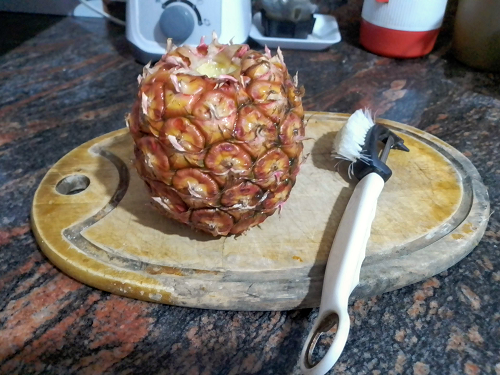Pineapple is a tropical fruit that many people love. Its flavor and nutritional content are welcome in many homes. This fruit can be prepared in addition to smoothies, desserts, and a rich cake that many love as is the pineapple cake. Eating it is delicious, sometimes it is very sweet and sometimes it can be a little sour, but it is still desired in many places.
This fruit is usually used all from its crown, its pulp, and the shell of the same, which sometimes by ignorance is overlooked and becomes part of the usable vegetable waste in agriculture. For this, I share how I usually take advantage of its shell or shell, cover as you want to call it.
Wash the fruit very well with a brush.

1 pineapple (whatever size you can find)
1 liter of water (11/2 can be used)
1 teaspoon star anise
1 teaspoon sweet aniseed (known as anisette)
Vegetable brush
Saucepan, knife


Cut the pineapple into several pieces to make it easier to remove the shell. Some people do it without cutting the fruit, it's all about how to make it easier. I usually do it as shown in the picture.



Once the shell is separated from the pulp, it is taken to the pot where it is placed next to the water to boil.


Add the star anise and the anicite to the water.

Let it boil over low heat, it gives off a very rich color throughout the house, along with the species that are placed in it.


Once the boiled water is ready, let it rest. It is strained to obtain delicious water. It can be drunk alone refrigerated, it can be used as a base for millet, melon, or guava juices.



You can drink it without sugar or with it. I like it unsweetened, very cold, and refreshing.


Cover image edited in Canva, photo property of the author. April 2024
Dividers Source
Photographs property of the author.
Translator DeepL

spanish version (click here)
La piña es una fruta tropical que a muchos les encanta. Su sabor, contenido nutricional es bienvenido en muchos hogares. Con esta fruta se puede preparar además de batidos, postres, una rica torta que a muchos les encanta como es la torta de piña. Comerla es deliciosa, a veces está muy dulce como en otras oportunidades puede conseguirse un poco ácida aún así es deseada en muchos lugares.
De esta fruta suele aprovecharse toda desde su corona, su pulpa y la concha de la misma, que a veces por desconocimiento se deja pasar y pasa a formar parte de los desechos vegetales aprovechables en la agricultura. Para ello, comparto cómo suelo aprovechar su concha o càscara, cobertura como quieran llamarle.
Lavar la fruta muy bien con el cepillo.
1 piña (el tamaño queue see encuentre)
1 litro de agua (puede utilizarse 11/2)
1 cucharadita de anis estrellado
1 cucharadita de anìs dulce (conocido como anisicito)
Cepillo para lavar vegetables
Olla, cuchillo
Cortamos la piña en various pedazos para queue see haga màs sencillo quitar la concha. Hay quienes lo hacen sin cortar la fruta, todo es como see haga màs sencillo. Por lo general lo hago como lo present en la image.
Ya separada la concha de la pulpa see lleva a la olla donde se coloca junto al agua para ponerla a hervir.
Junto al agua see le agrega el anìs estrellado y el anicito.
Se dejar hervir a fuego lento, ella desprende un color muy rico en toda la casa, junto a las especies que see le colocan.
Lista el agua hervida, see deja reposar. Se cuela obteniendo asì un agua deliciosa. Puede tomarse sola refrigerada, puede usarse como base para jugos de lechoza, melòn o guayaba.
Puede tomarla sin azùcar o con ella. A mi me gusta sin dulce, bien fria y como refresca.




















